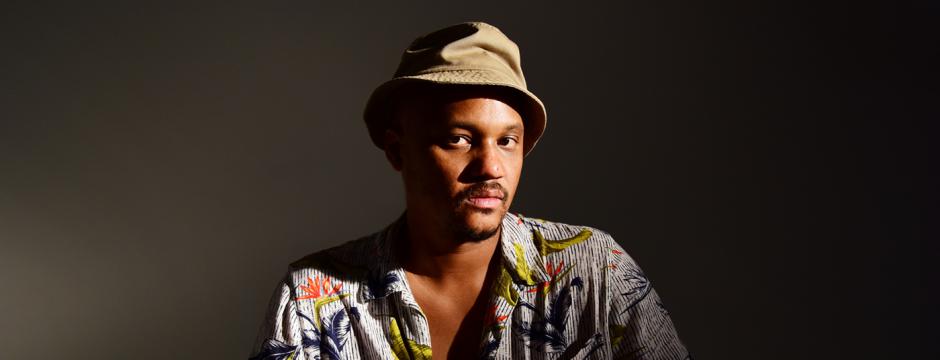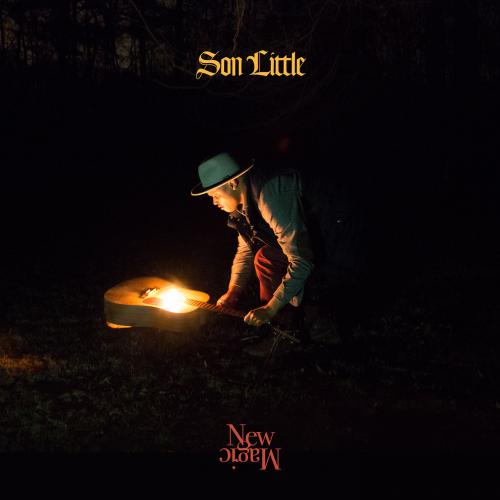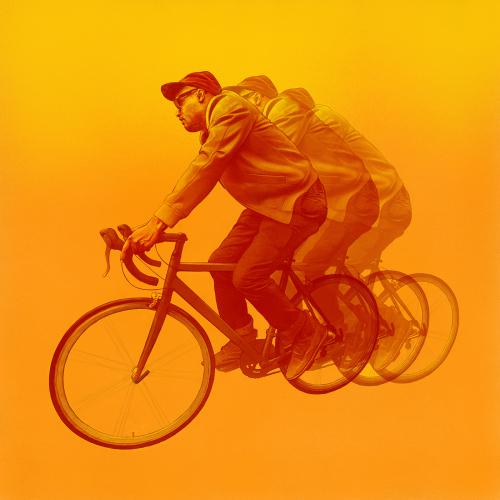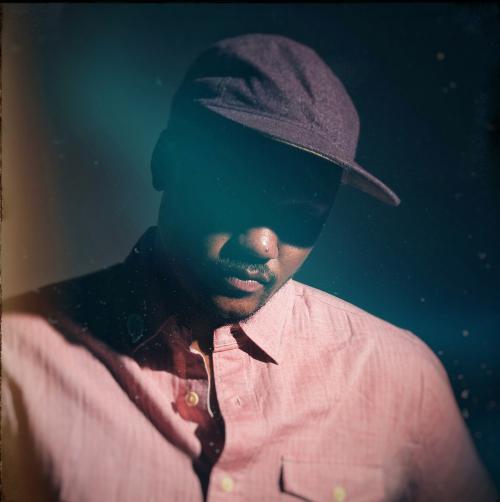SON LITTLE
Like Neptune
09.09.2022
Anti- Records / Indigo
Like Neptune entstand in einer Hütte mit Blick auf den Delaware River im Bundesstaat New York und ist eine offene und verletzliche Darstellung von ungezügelter Freude und Selbstakzeptanz. In diesem grünen Raum der Freiheit verwandelt Son Little den chronischen Schmerz der Selbstzweifel in ein wunderschönes Werk über die Überwindung eines Generationstraumas, schmückt den Altar des Ur-Blues und erhebt die Arbeit der Heilung zur hohen Kunst.
"Zu Beginn des Lockdowns ging ich in einen Schrank voller Gerümpel und fand ein paar Kisten mit meinen alten Schreibbüchern", erklärt Livingston. "Es stellte sich heraus, dass es 72 Bücher waren. Das älteste Buch bekam ich zu Weihnachten geschenkt, als ich 9 Jahre alt war. Darin schrieb ich Briefe an mich selbst über das, was in meinem Leben passierte. Eine Seite bezieht sich auf einen Nachbarn in Queens, der mich im Alter von 5 Jahren sexuell missbrauchte. Es war das erste und einzige Mal, dass ich mir diese Tatsache eingestand, bis ich nach meinem 19. Geburtstag meiner Mutter erzählte, was passiert war. Sie flehte mich an, eine Therapie zu machen. Ich ging unter Protest. Mein Versuch war nicht aufrichtig. Ich war nicht bereit. Ich dachte, ich könnte es einfach durchstehen." Es folgten Jahre voller Ängste, Depressionen, Panikattacken und Existenzängste, die oft durch die Wirkung von Alkohol, Drogen oder Sex betäubt wurden. Nach einem Autounfall und einer Verhaftung begab er sich 2017 schließlich wieder in Therapie. Indem er fortschrittliche Methoden wie EMDR und somatisches Heilen anwandte, begann Livingston mit Hilfe eines vertrauenswürdigen Therapeuten, die Wurzeln seines Traumas zu identifizieren und herauszufinden, wo es sich im Körper befindet. Der größte Durchbruch gelang ihm jedoch mit Internal Family Systems, einer Methode, die Reaktionen auf Traumaauslöser als unterschiedliche Entitäten oder "Teile" innerhalb der Person anerkennt und von dem Patienten verlangt, dass er im Wesentlichen Gespräche mit den verschiedenen traumatisierten Persönlichkeiten in ihm selbst führt.
Während er in seinen Tagebüchern wühlte und aufgrund der Pandemie in seinem Haus eingesperrt war, kehrte Son Little zum Beatmaking zurück, um den Kern von Like Neptune mit Hilfe von Apps auf seinem iPad zu entwickeln - eine Methode, die ursprünglich dazu diente, den quälenden Drang zu befriedigen, täglich unterwegs etwas zu kreieren; später erweiterte er die Programmierung und fügte Live-Instrumente in Ableton Live hinzu, während er LSD mikrodosierte und in die Klänge des David Bowie der 70er Jahre und des psychedelischen Amazonas-Cumbia derselben Zeit eintauchte. Like Neptune etabliert Son Little als polyglotten Übersetzer und rechtmäßigen Fackelträger der gefeierten musikalischen Tradition, die als Rhythm and Blues bekannt ist. Mit Like Neptune vollendet er die gewaltige Aufgabe, sich mit sich selbst zu konfrontieren und seinen Sound zu perfektionieren. Das Ergebnis ist ein zeitloses Werk, das seinen tiefen inneren Wunsch widerspiegelt, die strahlendste Version seiner selbst zu verkörpern und eine positive Kraft im Leben der Menschen um ihn herum zu werden.
++++++++++++++++++++++++
Band: Son Little
Album: aloha
VÖ: 31.01.2020
Label: ANTI- / Indigo
Website: www.sonlittle.com
“Letting go can be a scary prospect,” says Son Little. “But there’s beauty in it, too. Everything you leave behind opens up space for something new in your life.”
That was certainly the case with Little’s remarkable new album, ‘aloha.’ Written in only eight days and recorded at Paris’s iconic Studio Ferber, the entire project was an exercise in letting go, in ceding control, in surrendering to fate. While Little still plays nearly every instrument on the album himself, he put his songs in the hands of an outside producer for the first time here, collaborating with French studio wizard Renaud Letang (Feist, Manu Chao) to create his boldest, most self-assured statement yet.
Equal parts vintage and modern, the collection blends classic soul, old-school R&B, and adventurous indie sensibilities into a timeless swirl fueled by gritty instrumental virtuosity and raw, raspy vocals. It’s an ambitious work of vision and reflection, to be sure, but more than that, it’s an ecstatic testament to the freedom that comes from torching the map and trusting the currents of life to carry you where you belong.
“I’d always produced myself in the past,” explains Little, “but it’s easy to get caught up in an endless quest for perfection when you do that. Working with Renaud let me see my work from an outsider’s perspective, and that helped me get out of my own way.”
Born Aaron Earl Livingston to a preacher and a teacher in Los Angeles, Little first came to international prominence with his self-titled debut, released in 2015 on ANTI- Records. While Little’s collaborations with The Roots and RJD2 had already helped him make a name for himself by that point in his adopted hometown of Philadelphia, critics on both sides of the pond were quick to recognize the unique power of Little’s solo recordings, which stripped the past for parts that could be reconstituted into something wholly new and original. NPR hailed Little’s “impeccably crafted songs” as “honest and unpretentious,” while The Independent proclaimed him “a formidable talent,” and Vice declared that he was “dissolving the barrier between R&B and rock 'n' roll one tearjerker at a time.”
Songs from the record racked up roughly 30 million streams on Spotify alone, and the album landed Little dates with everyone from Leon Bridges and Kelis to Shakey Graves and Mumford & Sons alongside festival appearances at Bonnaroo, Newport Folk, and more. Never one to rest on his laurels, Little showed off his production chops the following year, earning a GRAMMY Award for his work helming Mavis Staples’ acclaimed ‘See That My Grave Is Kept Clean,’ and in 2017, he released a critically lauded sophomore album, ‘New Magic,’ which Paste said “did for the blues what Sharon Jones did for soul music.”
By now, it’s probably clear that Son Little likes to keep busy. In order to create ‘aloha,’ though, Little knew he’d have to do the unthinkable: sit still. The next thing Little had to let go of was even more challenging. Just weeks before he was set to begin assembling the album demos in Petaluma, California, his hard drive fried, taking with it nearly a dozen detailed demos for new songs. For a meticulous planner like Little, it was a devastating blow, one that left him with no choice but to start over.
“Losing all that material felt like a nightmare at the time, but I’ve since learned to see it as an opportunity,” he reflects. “If I hadn’t lost all those songs, I never would have written all the new stuff that became ‘aloha.’”
Beginning again with what was essentially a blank slate, Little penned much of the new album in Petaluma, in a tiny house and it’s adjacent barn. He let the songs take him on a journey of self-exploration there, examining the kind of big-picture questions that emerged from his subconscious in the quiet stillness: What am I doing? How did I get here? Who do I really want to be?
“I let the dust settle after a hectic year, and stopped worrying about the music for a minute,” explains Little. “I tried to just tune in to what was happening in my mind, to just be present in my body. It was liberating.”
That sense of liberation is clear from the very beginning of ‘aloha,’ with album opener “hey rose” showcasing Little’s freewheeling way with words and lean, swaggering delivery. Inspired by the sense of infatuation that comes with new love, the track sets the stage for an album full of unflinching self-examination and daring sonic fusion. Little injects trippy psychedelia into Sam Cooke soul on the slow-burning “about her. again.,” channels Prince and Michael Jackson on the breezy “3rd eye weeping,” and marries sparse, distorted guitar tones with clean, dense vocal harmonies on the infectious “mahalia.”
“That song’s an apology delivered at the start of a relationship, instead of the end, when it all falls apart” says Little, who often collapses time and space in his writing by combining characters and scenes from throughout his life. “I’d been thinking a lot about how I find myself repeating the same mistakes in different areas of my life. I find myself drawn over and over to the same qualities in different people, and sometimes the dynamic can become toxic. Pointing the finger is easy. I’m trying to be better at acknowledging my part of the problem.”
Recognizing the power of our own self-destructive tendencies is a recurring theme on ‘aloha.’ Little mourns the suicide of a beloved uncle on ‘suffer’, using addiction and mental illness as a lens to explore forgiveness and empathy, laments the rapidly deteriorating world his two children are set to inherit on ‘o clever one,’ and meditates on the dangers of succumbing to passion at the expense of reason on “belladonna.”
“There’s a lightness that comes from being so deeply in love with a person or an idea,” says Little. “But there’s a danger that comes with it, too. It’s like a drug: a little bit and you feel incredible; too much and it kills you.”
It would be easy to feel helpless in the face of such inexorable forces, to feel as if we are prisoners of fate rather than masters of our own destiny, but Little instead finds peace in perseverance on the album. “Hallelujah,” he sings on the gorgeous ‘neve give up,’ “though I’m battered and blue / feel like I’m born to lose…Never will I give up.” It is a potent reminder that letting go doesn’t mean giving in; in fact, quite the opposite. Letting go can be an act of defiance, of growth, of empowerment. Letting go requires a leap of faith, and, in Son Little’s case, that faith has been richly rewarded. Whether that means this album represents the end of one chapter or the beginning of the next is impossible to know just yet, but in either case, there’s really only one thing to say: aloha.
TRACKLIST AND DESCRIPTION:
1. hey rose -- is love that walks the tightrope; maybe is some dark obsession in disguise
2. about her. again -- is love that goes away but just keeps coming back and you can't quite explain it.
3. mahalia -- is love you know is doomed and you wish so badly it weren't but it is, so you want to let them know
4. bbbaby -- is young love in full bloom: beautiful and stupid
5. suffer -- we all struggle so much and blame ourselves for things we don't control, or at least i do. it's about forgiving yourself
6. that's the way -- 100% dedication to pleasing your lover
7. 3rd eye weeping -- socio-spiritual fatigue in the 21st century
8. don't wait up -- another warning for your lover--it's going to be a long night
9. belladonna -- just the feeling of excitement of seeing and getting to know someone for the first time and falling into a rhythm with them
10. neve give up -- perseverance
11. o clever -- the joys and agonies of parenthood; the cycle of generations; the cost of living
12. after all -- the sad feeling of loving someone but knowing you have to let them go
Info zu vorherigem Release:
Album: New Magic
VÖ: 15.09.2017
Label: ANTI- / Indigo
What is the new magic of music? If you trace the path of a plan back to its beginnings, what do you find? Is it a tree, growing from seed with deep roots planted in fertile soil, branches arcing out in all directions? Or a spark in the dark, an electrical charge? Is it a waterway, with swirling currents raging to create a river? Or is it a snowflake, falling from on high and dropping down to earth with a singular splash?
For Son Little, the genesis of a musical idea—the magic—remains largely a mystery. But his kinetic ability to summon that energy all the same, to command it, hold onto it, and set it in motion, is the stuff of alchemy.
“The magic is this well I can draw from; you can’t necessarily see it, you just have to believe that it’s there,” he says. “If you believe, then you can reach your hand down in there and get it wet. But if you don’t feel like it’s there, it won’t be.”
Son Little, the singer and songwriter born Aaron Livingston, is the easygoing musical alchemist of our time. He is a conjurer, and much like those of his heroes Stevie Wonder and Jimi Hendrix, his songs are deconstructions of the diaspora of American R & B. Deftly he weaves different eras of the sound—blues, soul, gospel, rock and roll—through his own unique vision, never forced, always smooth, each note a tributary on the flowing river of rhythm and blues. The currents empty into an estuary, and into this well water Son dips his bucket—trusting innately in the magic’s existence. And now, with his second full-length album, New Magic, he has delivered a profound statement, a cohesive creation that captures the diverse spirit of American music in a fresh and modern way.
On the heels of his 2015 self-titled debut and the 5-song EP, Songs I Forgot, that came before it, Son Little found his reach steadily growing. His song “Lay Down” had been played over seven million times on Spotify, he had toured the world with artists as diverse as Leon Bridges, Kelis, Mumford & Sons, and Shakey Graves in addition to his own headlining runs, and also became a Grammy Award winning producer, earning a 2016 Best Roots Performance award for his work on Mavis Staples’s “See That My Grave Is Kept Clean.” But in the midst of all this success, so too did he find that the window for writing new songs was shrinking. Where his previous releases had been culled from various eras and scattered sessions early in his career, he now craved an opportunity to sit and write a new album in a distinct, unified direction, one that would establish his place in the world of black music. The only problems were: when, and how?
“I was on the road so much and found myself wanting to write, but I couldn’t really find time or space to do it in the way I wanted,” Son Little says. “I was playing around with beats or messing with chord changes; I had all these little fragments, thinking I would later piece them together. I kept the wheels turning by doing those exercises, but I knew it would feel really luxurious to be able to sit down by myself and write something from scratch. I was really hungry to get in that space and chisel out something new, without being interrupted by sound checks and rides in vans and radio. All that stuff is cool and I was having a blast touring, but a crucial part for me was missing. I wanted the writing to be broken up as little as possible.”
In the meantime, all that motion was filling him with both confidence and inspiration for the next step. The limitations he encountered while performing a debut record with so much studio sorcery via a live band onstage each night were influential in terms of how he began thinking about a followup. “I’ve often been a guy who was somewhat hiding behind the guitar,” he says. “Getting used to being out front and exposing the guitar and my voice, and leaving a lot of space in the material, all really inspired me and got the wheels turning for what I would do with the next group of songs.”
Sometimes, in order to see the stars, you have to get far away from the city lights. Finally, in the fall of last year, Son Little found himself in such a place, and it was there at the end of a tour in the remote, tropical Northern Territory of Australia that he looked up in the sky and saw the perfect alignment. Benefitting from several hours free on a string of consecutive days as well as the excitement of alien terrain and the inherent magic in a borrowed instrument, he felt things starting to come together.
“The Northern Territory is a place where things are moving a little slower than anywhere else,” he says. “There were these big crocodiles and enormous bats, just wild things I’d never seen. I found myself with a few hours to kill a couple days in a row, and I set up in the hotel and just kinda followed the process: I found a rhythmic idea I liked and then sang and played a little guitar over it. Like a tip jar in a cafe that fills up after the first dollar goes in, you need that first little piece to slide into place and then the whole thing comes together. I ran off five songs all in the same day.” (Three of those songs, “Kimberly’s Mine,” Charging Bull,” and “Mad About You,” would make the album.)
That process to which he refers stems from an experience he encountered while writing a cornerstone of his early material, the soul-scorching, chanty-like “Your Love Will Blow Me Away When My Heart Aches,” one of few moments of inspiration he can still visualize. The song came to him while standing in his bedroom; beginning with a couple of words and a tempo, Son Little started to pound his fist on the dresser and made up the song’s melody on the spot. “I was banging on the dresser, and then I don’t know what happened. There was no melody, no words…and now there is. I know now that if I get part of the melody, a phrase or two, and a tempo, then the rest will follow. So I wanted to follow that pattern for the new songs and let the idea grow from that without worrying about what the production would sound like or which guitar to use. I was more focused on finding the song and the arrangement.”
But, as it happened, the guitar seemed to find him, too. “All those songs in Australia were written with one mic and an acoustic left-handed guitar I was playing upside-down,” he says. “It was borrowed from the Australian singer Gurrumul, a blind Aboriginal musician with this angelic voice. I needed a guitar and he was nice enough to loan it to me; I took it upstairs and all those songs came out of it. You hear people say guitars have songs in them, and that one certainly did.
Whether or not Son Little was aware at the time of the overt connection to his pair of R & B heroes—Stevie and Jimi - that lending presented is unclear. Let’s, again, chalk it up to the magic.
“Those two dudes are a little bit alone there; I can’t see how there can be a higher level of musical genius after Stevie and Jimi,” he says. “I do think of both of them as R & B guys, but neither was trying to contain themselves there in any way. They were letting themselves be influenced by other stuff, be it jazz or Latin music or whatever, but they were just making songs and musically doing what felt good. That’s what I wanted to do here. I do see myself that way, in the branches of the R & B river.”
(A quick but magical aside: In the winter of 2015, Son found himself invited to a reading a friend was giving at Electric Lady Studios in New York City, the legendary underground recording facility conceived and once owned by Jimi Hendrix himself. After the event he was invited to spin his debut album on the studio’s speakers, and while it played an employee asked him if he would like to “see the river”—a trickling branch of the seldom seen Minetta Creek that runs under parts of Manhattan. “I put my record on—which was a trip, like I was playing it for Jimi—and we went back in the corner behind where the amps are set up, and they pulled this panel up, and sure enough, there’s running water right under the floor. You can stick your hand in there and get it wet.”)
Flowing water is a recurring theme in Son Little’s music, in addition to its symbolic inspiration. From his debut’s hit “The River” to a lyric in “Mad About You” (“Now you say it’s different, baby/ After I took you to the river”), his work tends to be thematically waterlogged. “My well is fed by the different tributaries, the other water sources that pour into it,” he says. “When you dip your bucket into it, you’re gonna get all kinds of different water. Water behaves that way underground, too; you can dig if you know where it’s at, and there are people, like the Aboriginal water diviner, who can find the water. My music has a kind of magic in it, being connected to whatever those forces are.”
Having been handed the divining rod in Australia, Son Little was able to connect the dots and finish New Magic by early spring. The trio written Down Under form the heart of the album’s vibe, with “Kimberly’s Mine” leading the record off with its Old Blues soap-operatic feel, and “Charging Bull”’s funky, fevered groove and the D’Angelo-inspired R & B minimalism of “Mad About You”—a lovelorn, aching track Son Little claims found itself only when he stripped it down to its barest essentials—holding anchor in the middle. But the song that serves as the album’s true centerpiece is “Blue Magic,” a Philly Soul inspired number deconstructed almost like a rap song or the best of production savants like J Dilla, Madlib, and Sparklehorse’s Mark Linkous, complete with chiming glockenspiel bells and old school female backing vocals. With its origins predating the Australia trip, the song has the appeal of an instant classic, a feeling that did not escape its maker, either.
“I knew ‘Blue Magic’ would be my focal point from the second I made it up,” Son Little says. “I was just goofing around before a show—and I wish I could explain where something like this comes from but I have absolutely no idea—and I was freestyling with the guitar. The thought occurred to me that people were characterizing my music as this new blues thing, even though I was never exactly trying to heroically ‘save the blues’ or anything like that, or even put myself in a place where everything had to be bluesy. But suddenly I’m telling you in the song I’ve got the ‘blue magic,’ and even though there are things called ‘blue magic’ I hadn’t seen that phrase anywhere or heard anyone say it. But I said it, and then there’s a pressure to back it up, to support that claim. I think I’m addicted to that pressure; this thing is hanging in the balance, and the whole thing can go up in smoke if I don’t figure this out and put these pieces together in motion. I enjoy the feeling of not knowing what’s gonna happen from there; it doesn’t always end perfectly but I think you have to resolve that pressure, and not knowing how is really exciting to me. That feeling is somewhat hanging over this whole album: watch me make something out of thin air.”
Following that lead are the pair of “Bread and Butter,” a playful, modern take on James Brown, and “The Middle,” a classic drinking-blues, both deconstructed through a filter of musical Cubism. “ASAP” is Son Little’s fiery, direct take on a Hendrix rock and roll song, and “Letter Bound” reminds of a yearning, crooning Bobby Womack joint, with the “little cry” in Son Little’s voice, as Mavis Staples calls it, taking the spotlight. The album ends with the ethereal, gospel-tinged number “Demon to the Dark,” which serves as the singer’s conversation with Washington Phillips, a little known blind musician and church deacon from early in the 20th century whose song “What Are They Doing in Heaven Today” utilized the dulceola, a novelty instrument comprised of two autoharps essentially stuck together. Phillips was a man of strong faith, a deacon in his church, and in his music Son Little found a source of forgiveness as well as an inspiration to carry on. As chiming strains of Omnichord take us out, the electricity in the air is palpable, the belief and trust in the spark at its peak.
What is the new magic? How did that deep well get there in the first place, and what is the source water of all these confluents pouring in? To Son Little, there is an attitude running through his makings and his music, a mighty river of superstition and Spanish castles that runneth over. And despite its murky and mysterious origins, the musician’s divination ability is just that—divine.
“There is this vein of the blues in it, and it can be distilled or boiled down just to the guitar and voice—or even just the voice,” he says. “And that process of me in my bedroom, making ‘Your Love’ with the dresser as the drum—I did that same thing as I wrote these songs. It’s that same scenario of making something out of nothing. And even if I am capable of doing that, I can’t really explain it. That’s the gist of the magic. I don’t know where it comes from, but it’s there, and I can call on it. I can call on it standing by the dresser, walking down the street, driving a car, on a train, a plane, in a hotel room, in the green room, during an interview…it’s just there. I’m trying to pay tribute to that fact. It’s had a really powerful and in some ways increasingly healing effect on my life. Hopefully other people have that experience with it as well. I’m just happy that it’s there, wherever it comes from.”




